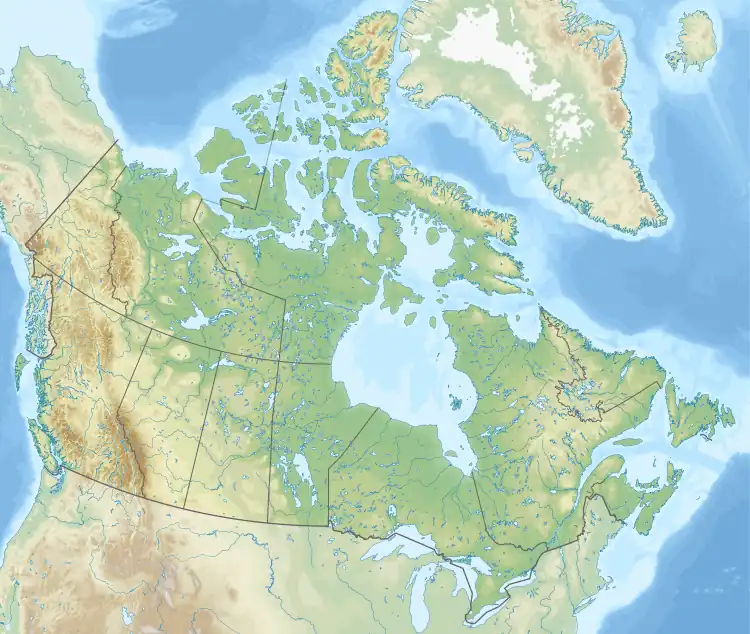| Monach Formation | |
|---|---|
| Stratigraphic range: Valanginian | |
| Type | Formation |
| Unit of | Minnes Group |
| Underlies | Bickford Formation |
| Overlies | Beattie Peaks Formation |
| Thickness | maximum 350 m (1,150 ft) |
| Lithology | |
| Primary | Sandstone |
| Other | Siltstone, mudstone, coal |
| Location | |
| Coordinates | 55°51′00″N 122°30′00″W / 55.8500°N 122.5°W |
| Region | |
| Country | |
| Extent | Western Canadian Sedimentary Basin |
| Type section | |
| Named for | The Monach |
| Named by | W.H. Mathews, 1947[1] |
 Monach Formation (Canada) | |
The Monach Formation is a geologic formation of Early Cretaceous (Valanginian) age in the Western Canada Sedimentary Basin that consists primarily of sandstone. It is present in the northern foothills of the Canadian Rockies and the adjacent plains in northeastern British Columbia.[2][3][4]
Lithology
The Monach Formation consists primarily of clean, white to light grey, well sorted, medium- to coarse-grained quartzose sandstone, and grey to brown, thin bedded to finely laminated argillaceous sandstone, with lesser interbeds of dark grey mudstone, thin coal seams, carbonaceous shale, and rare conglomerate.[2]
Environment of deposition
The Monach Formation was deposited in marine and nonmarine environments within and adjacent to the Western Interior Seaway. Depositional settings ranged from marine to shoreline, deltaic, river channel, floodplain, and swamp environments.[2]
Paleontology and age
The age of the Monach Formation has been determined from its fossil fauna, primarily species of the bivalve Buchia.[2]
Thickness and distribution
The Monach Formation is present in the foothills of the Canadian Rockies and the adjacent plains in northeastern British Columbia. It extends from the Chowade River in the north, to south of the Sukunka River where it grades into the Gorman Creek Formation. It attains a maximum thickness of 350 m (1,150 ft) in the foothills, and thins to zero about 80 km (50 mi) or less beyond the eastern edge of the foothills where it was removed by erosion prior to the deposition of the Cadomin Formation.[2][4]
Relationship to other units
The Monach Formation is part of the Minnes Group. It was deposited conformably on the Beattie Peaks Formation and is conformably overlain by the Bickford Formation, both of which also belong to the Minnes Group. To the east where it was removed by erosion, the Monach Formation is unconformably overlain by the Cadomin Formation. To the south it grades into the Gorman Creek Formation.[2][3][4]
References
- ↑ Mathews, W.H. 1947. Geology and coal resources of the Carbon Creek, Mount Bickford map area. British Columbia Department of Mines, Bulletin 24, 27 p.
- 1 2 3 4 5 6 Stott, D.F. 1998. Fernie Formation and Minnes Group (Jurassic and lowermost Cretaceous), northern Rocky Mountain foothills, Alberta and British Columbia. Geological Survey of Canada, Bulletin 516.
- 1 2 Mossop, G.D. and Shetsen, I. (compilers), Canadian Society of Petroleum Geologists and Alberta Geological Survey (1994). "The Geological Atlas of the Western Canada Sedimentary Basin, Chapter 18: Jurassic and Lowermost Cretaceous strata of the Western Canada Sedimentary Basin". Retrieved 2016-06-20.
{{cite web}}: CS1 maint: multiple names: authors list (link) - 1 2 3 Glass, D.J. (editor) 1997. Lexicon of Canadian Stratigraphy, vol. 4, Western Canada including eastern British Columbia, Alberta, Saskatchewan and southern Manitoba. Canadian Society of Petroleum Geologists, Calgary, 1423 p. on CD-ROM. ISBN 0-920230-23-7.
See also
- List of fossiliferous stratigraphic units in British Columbia
- Various Contributors to the Paleobiology Database. "Fossilworks: Gateway to the Paleobiology Database". Retrieved 17 December 2021.